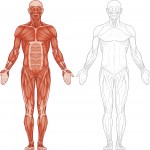
What is Fascia
1 CommentHave you ever heard of fascia? In the physical medicine world, fascia has a lot of buzz right now. We have known about fascia for a long time now, but are only now starting to realize how amazing and important it truly is. If the word sounds familiar to you, you are probably thinking of terms like ‘plantar fasciitis’ or ‘myofascial release’. And if you haven’t heard this term, well you’re in the right place!
What IS Fascia?
 Fascia is connective tissue, primarily collagen, that runs throughout the entire body. It attaches, separates, and supports everything in the body. There are multiple layers of fascia from superficial to very deep within the body, each part doing its own job but also working together as a whole. Some people describe fascia as a spider web of connective tissue that covers you from head to toe. Others call it the ‘Saran wrap’ of the human body. A good visual is picturing an orange. It is one individual piece of fruit at first glance, but when you peel the outer layer, you will find neatly wrapped compartments on the inside too, divided by thin layers of tissue.
Fascia is connective tissue, primarily collagen, that runs throughout the entire body. It attaches, separates, and supports everything in the body. There are multiple layers of fascia from superficial to very deep within the body, each part doing its own job but also working together as a whole. Some people describe fascia as a spider web of connective tissue that covers you from head to toe. Others call it the ‘Saran wrap’ of the human body. A good visual is picturing an orange. It is one individual piece of fruit at first glance, but when you peel the outer layer, you will find neatly wrapped compartments on the inside too, divided by thin layers of tissue.
But what does Fascia DO?
Fascia is the reason your stomach stays where your stomach should be! And other organs respectfully… Fascia connects muscles to bones (yes, tendons are a part of the fascial system). Fascia cushions your vertebrae (yes, discs are a part of the fascial system, too). And, fascia is a large part of how we move freely through space, or, potentially, how our movement becomes painful and restricted. Fascia is everywhere! In fact, it is likely because of this fact that it was over looked in the past.
When you dissect a human cadaver, you are constantly cutting through and scraping away the fascia in order to view the human body as most of us recognize it. It took researchers a while before realizing that this fascia plays a crucial role in our health and well being. Fascia needs to be unrestricted and ‘juicy’ (picture a wet sponge vs. a dry brittle one) in order to do its job. Without healthy fascia our range of motion is limited, we are injury prone, and have diminished proprioception (body awareness, balance, etc.)
How to keep Fascia happy and healthy:
- Eat right and drink plenty of fluid. When we are dehydrated and undernourished, our bodies do not perform the way that they are designed to perform.
- Get plenty of varied exercise. Exercise in itself is important, but for truly healthy fascia, you want to mix it up. For example, if you are a runner, you want to also incorporate yoga and weight training. If you are a swimmer, you might want to add in tennis or walking into your routine. Moving our bodies fully and completely helps keep fascia happy.
 Get massage therapy or other fascial body work. There are lots of highly trained manual therapists out there that can help you with your fascial health. There are myofasical massage therapists, physical therapists that perform techniques like ART and other manual therapies, and specialists that do fascial stretching.
Get massage therapy or other fascial body work. There are lots of highly trained manual therapists out there that can help you with your fascial health. There are myofasical massage therapists, physical therapists that perform techniques like ART and other manual therapies, and specialists that do fascial stretching.- Stop being sedentary. Research shows that just getting exercise a few times a week, does not undo a life style of sitting all day. We NEED to find ways to get up and move throughout the day. Sitting at a computer for 8 hours is simply not an option if you’re concerned about your total body wellness. Take breaks, take the stairs, sit on an exercise ball, every 30 mins get up and do a 5 min exercise at your desk, walk to lunch, look into a standing desk or treadmill desk if possible. When you get home at night, try not to sit in front of the TV or play on your phone.
So, even though you don’t know it’s there, fascia is playing a big role in your health and wellness- treat it with love.

1 Comment
ZU
Thank you for great information. I used to take it lightly to be in motion frequently. Not anymore.